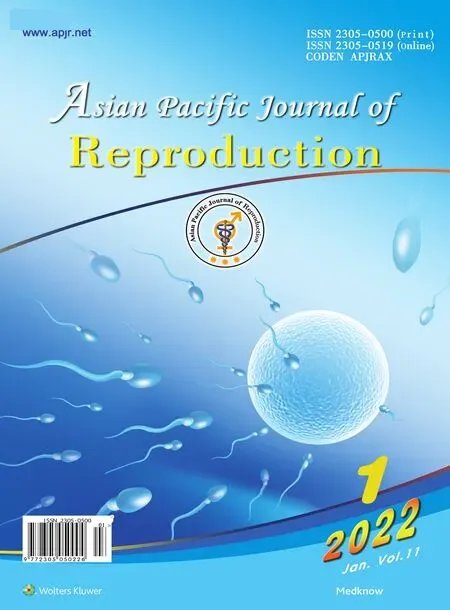Successful live birth after intracytoplasmic sperm injection using testicular sperm in non-mosaic Klinefelter syndrome
Sonia Jellad, Ramzi Arfaoui, Nesrine Souayah, Fatma Hammami
1Department of Sterility Exploration and Assisted Medical Procreation, Military Hospital of Tunis, 1008, Montfleury Tunis, Tunisia
2Faculty of Medecine of Tunis, University of Tunis El Manar, Tunisia
3Department of Gynecology, Military Hospital of Tunis, Tunisia
Klinefelter syndrome represents one of the most common male sex chromosome disorders with a prevalence of 1 out of 500 male newborns[1]. The syndrome is marked by the presence of an additional X chromosome in human males. It manifests mostly as 47, XXY, and can take the mosaic form as 46, XY/47, XXY.
A 36-year-old adult had been referred to our department for primary infertility exploration. Prior semen analyses had demonstrated azoospermia. The patient had no particular pathological history.The physical examination revealed a well-masculinized body with normal hair density and distribution, without gynecomastia.However, genital examination revealed bilateral hypotrophic testes. The hormonal assessment confirmed the diagnosis of nonobstructive azoospermia with elevated gonadotropins and sustained testosterone production, follicle-stimulating hormone (FSH) at 24, 46 mU/mL, luteinizing hormone (LH) at 13, 11 mU/mL,total testosterone at 8, 8 ng/mL, respectively. Scrotal ultrasound showed bilateral atrophic testes with normal arterial and venous flow on doppler imaging. Karyotype confirmed the diagnosis of non-mosaic Klinefelter syndrome (47, XXY). Testicular sperm extraction proceeded prior to female partner intervention. The testis biopsies were mechanically minced using sterile needles in order to facilitate sperm release from the seminiferous tubules. Some rare motile sperm cells were detected under inverted microscope at 400× magnification in slides from both the testes. The testicular cell suspension was prepared and cryoconserved for later use.Furthermore, his partner was 32 years old without any pathological history. The woman’s basal hormonal investigation showed elevated FSH and LH at 11.28 and 9.18 mU/mL, respectively. Ovarian stimulation started by the daily administration of recombinant FSH at 300 IU according to the antagonist protocol. Five mature oocytes were identified in the aspirated follicular fluid. Mature oocytes were injected with the frozen-thawed testicular sperm and placed in culture media in 37°℃ and 6% CO2. We confirmed normal fertilization in 3 oocytes 19 h after microinjection. Then, at 44 h,we obtained one embryo scored as 5-1-2 according to Biologistes des Laboratoires d’Etude de la Fecondation et de la Conservation de l’Oeuf (BLEFCO) classification that was replaced in the same day into the wife’s uterus. The other two zygotes failed to segmentate.Later, pregnancy with male f?tus was established and developed.Obstetric ultrasonography was normal. The woman delivered a healthy boy at 38.5 weeks’ gestation with normal karyotype.
The non-mosaic Klinefelter syndrome results from non-disjunction of paired X chromosomes. It can occur either during stage Ⅰ orⅡ of germ-cell meiosis during oogenesis or spermatogenesis.Less than 10% of these males are diagnosed before puberty and the most common presentation is an adult who experiences infertility.The testes of Klinefelter syndrome males stop growing by the puberty age. Germ cells differentiate to the spermatogonium stage and then undergo apoptosis instead of entering meiosis; therefore,no spermatozoa is present in the testes. Although some men may still have small residual foci with preserved spermatogenesis and may benefit from assisted reproductive techniques[1]. By the end of puberty, few or no germ cells remain. Only a few seminiferous tubules with complete spermatogenesis can be seen, and most tubules are settled with fibrosis. As a result, the testicular endocrine and exocrine functions degenerate and as a response, an hormonal axis alteration is marked by elevated basal FSH and LH levels[2].Non-obstructive azoospermia is present in 90% to 96% of nonmosaic Klinefelter syndrome patients and 50.0% to 74.4% of mosaic forms[3]. Assisted reproductive techniques have revolutionized fertility prognosis in Klinefelter males and paternity is now possible using intracytoplasmic sperm injection (ICSI)[4]. The most promising predictive factor of success rate of sperm retrieval reported is age.In fact, after the age of 35 years chances of positive testicular sperm extraction decrease significantly[5]. Focus was put on the genetic risk to the offspring of patients with non-mosaic form. Yet, this risk has not been found to be more significant than patients with non-obstructive azoospermia and with normal karyotype. Most new borns of Klinefelter men undergoing ICSI have a normal karyotype[6]. Chromosomal analysis of testicular spermatozoa shows a high proportion of normal haploid cells[6].
Ethics statement
This study was approved by the ethics committee of the local hospital.
Conflict of interest statement
The authors declare that there is no conflict of interest.
Authors’ contributions
Sonia Jellad, Ramzi Arfaoui, Nesrine Souayah and Fatma Hammami contributed to the study design, exploration and therapeutic management of the case report. Sonia Jellad, Fatma Hammami and Nesrine Souayah drafted and revised the manuscript.All authors approved the final manuscript.
 Asian Pacific Journal of Reproduction2022年1期
Asian Pacific Journal of Reproduction2022年1期
- Asian Pacific Journal of Reproduction的其它文章
- An implementation study of barriers to universal cervical length screening for preterm birth prevention at tertiary hospitals in Thailand: Healthcare managers’ perspectives
- Uptake of in-vitro fertilization among couples attending fertility clinic in a tertiary health institution
- Recurrent ovarian endometrioma after conservative surgery: A retrospective study
- Blepharis persica increases testosterone biosynthesis by modulating StAR and 3 β-HSD expression in rat testicular tissues
- Taurine in semen extender modulates post–thaw semen quality, sperm kinematics and oxidative stress status in mithun (Bos frontalis) spermatozoa
- Effects of enzymatic and non-enzymatic antioxidants in diluents on cryopreserved bull epididymal sperm
